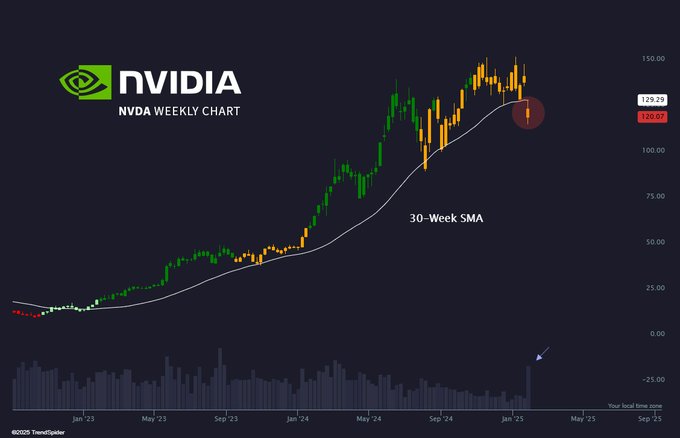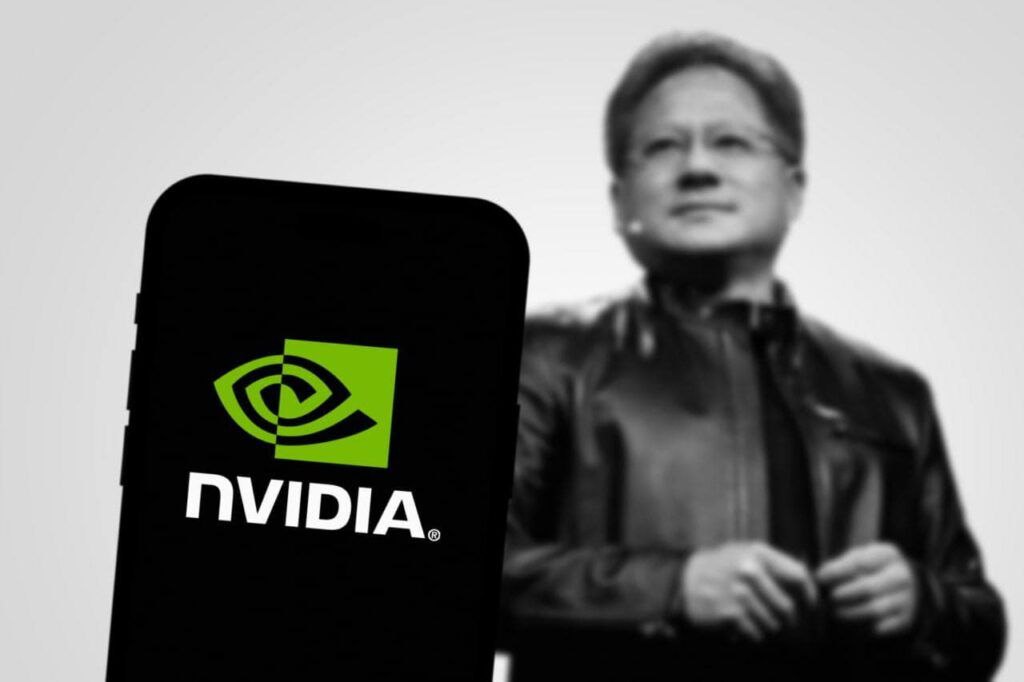The share price of chipmaker Nvidia (NASDAQ: NVDA) has entered bear territory, falling below the $120 mark as the market reacts to the impact of Donald Trump’s tariffs.
Over the past week, Nvidia has faced turmoil, first taking a hit following the DeepSeek sell-off. Before it could stage a recovery and target gains above $120, the stock has now been weighed down by the effects of the initial round of tariffs affecting goods entering the U.S. from Canada, Mexico, and China.
Specifically, NVDA’s share price dropped as much as 6.5% in overnight trading to $112.09, reflecting a plunge of 27% from its record high.

At the close of the January 31 session, the equity ended the day at $120.07, down over 3%. Meanwhile, the technology giant is extending its weakness in pre-market trading on Monday, falling another 2.8% to $116.
To put the severity of the last market close into perspective, the NVDA share price plunged below its 30-week simple moving average (SMA) for the first time in over two years. This key technical breach generally points to potential weakness in the long term.

Why Nvidia stock is crashing
Nvidia’s current losses reflect investor reaction to the tariffs, which directly impact technology firms that depend heavily on global supply chains.
Generally, investors are anticipating possible increases in costs for components manufactured abroad, potentially squeezing Nvidia’s margins and affecting its profitability forecasts.
On January 27, NVDA initially erased nearly $600 billion in market cap as DeepSeek’s cost-effective artificial intelligence (AI) model was unveiled, raising concerns about future demand for Nvidia’s expensive chips.
While some analysts reiterated that the DeepSeek sell-off was an overreaction, others warn that cheaper AI alternatives could disrupt Nvidia’s dominance.
However, the Santa Clara-based firm maintains that its high-performance chips remain essential, with more in the pipeline, such as the next-generation Blackwell.
AI predicts NVDA share price
To determine how Nvidia’s stock might trade in the short term, Finbold turned to its AI prediction tool that leverages several models. Between February 3 and March 10, 2025, the tool predicts a bullish turn for NVDA, setting an average valuation of $146.67, a 25.58% gain.
GPT-4o projects $135, citing stable market conditions, while GPT-4 mini expects a $150 price target, driven by positive momentum and a potential golden cross. On the other hand, Grok 2 Vision is the most optimistic, forecasting $155, a 32.71% increase, fueled by AI growth, easing interest rates, and strong technicals.

Wall Street’s take on NVDA stock price
As things stand, Wall Street analysts have maintained a bullish stance on Nvidia’s stock price despite the DeepSeek chaos. It will be keen to monitor if the expert revises their outlook given the new concerns from the trade tariffs.
Some of the most recent bullish takes on Nvidia emerged on January 31 when Tigress Capital’s Ivan Feinseth upgraded his rating from a ‘Buy’ recommendation to a ‘Strong buy.’ The analyst also increased his NVDA stock price target to $200 from $170 because DeepSeek’s release has little impact on Nvidia’s potential, as its advanced products remain crucial for driving technology forward.
On January 27, UBS analyst Timothy Arcuri reaffirmed a ‘Buy’ rating and a $185 price target for Nvidia, downplaying DeepSeek’s impact. UBS expressed confidence in Nvidia’s strong financial outlook and robust first-quarter guidance. The firm highlighted improved Blackwell chipset yields and a product mix increasingly favoring Blackwell over Hopper.
One of the dissenting takes on Nvidia was shared on January 28 by Morgan Stanley’s Joseph Moore, who cut NVDA’s price target to $152 from $166, citing potential cost-reducing AI innovations from DeepSeek that could impact the company.
Featured image via Shutterstock









